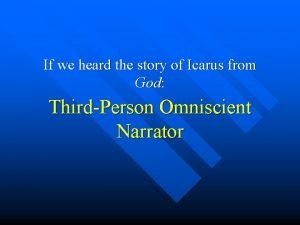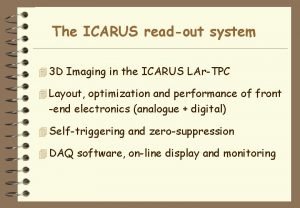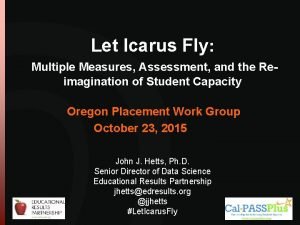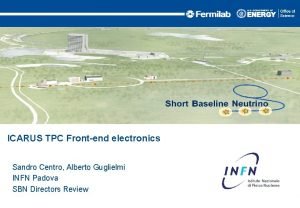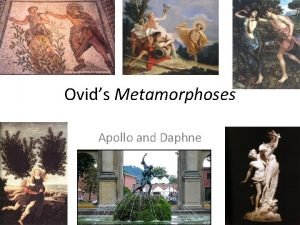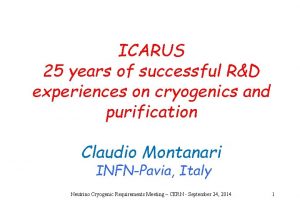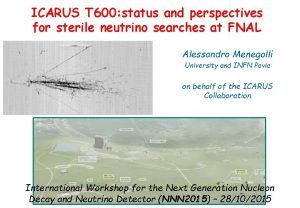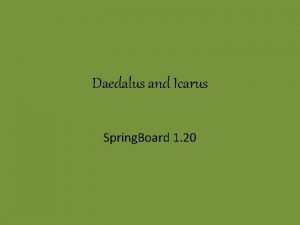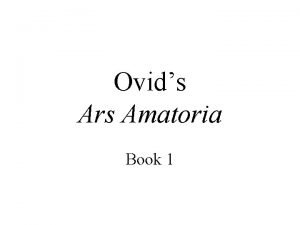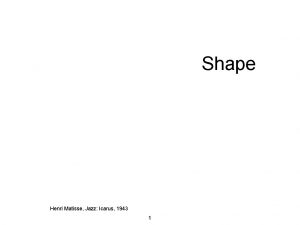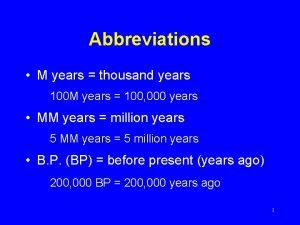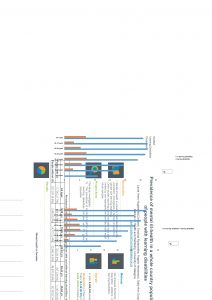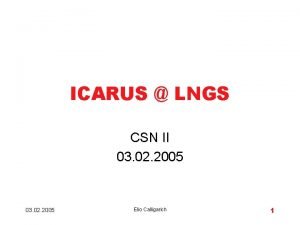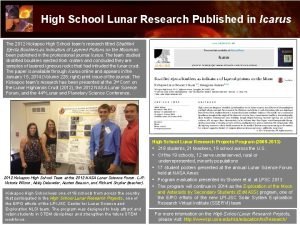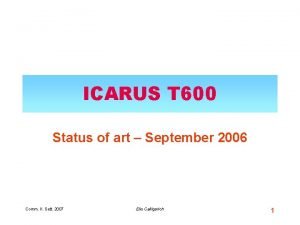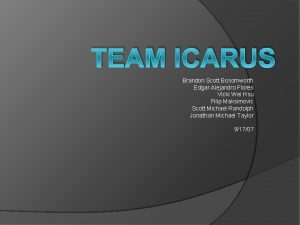ICARUS 25 years of successful RD experiences on
























- Slides: 24

ICARUS 25 years of successful R&D experiences on cryogenics and purification Claudio Montanari INFN-Pavia, Italy Neutrino Cryogenic Requirements Meeting – CERN - September 24, 2014 1

The ICARUS Collaboration M. Antonello 1, B. Baibussinov 2, V. Bellini 4, 5, H. Bilokon 6, F. Boffelli 7, M. Bonesini 9, E. Calligarich 8, S. Centro 2, 3, K. Cieslik 10, D. B. Cline 11, A. G. Cocco 12, A. Curioni 9, A. Dermenev 13, R. Dolfini 7, 8, A. Falcone 7, 8, C. Farnese 2, A. Fava 3, A. Ferrari 14, D. Gibin 2, 3, S. Gninenko 13, F. Guber 13, A. Guglielmi 2, M. Haranczyk 10, J. Holeczek 15, A. Ivashkin 13, M. Kirsanov 13, J. Kisiel 15, I. Kochanek 15, A. Kurepin 13, J. Łagoda 16, F. Mammoliti 4, S. Mania 15, G. Mannocchi 6, V. Matveev 13, A. Menegolli 7, 8, G. Meng 2, G. B. Mills 17, C. Montanari 8, F. Noto 4, S. Otwinowski 11, T. J. Palczewski 16, P. Picchi 6, F. Pietropaolo 2, P. Płon ski 18, R. Potenza 4, 5, A. Rappoldi 8, G. L. Raselli 8, M. Rossella 8, C. Rubbia 19, 14, a, P. Sala 20, A. Scaramelli 20, E. Segreto 1, D. Stefan 1, J. Stepaniak 16, R. Sulej 16, C. M. Sutera 4, D. Tlisov 13, M. Torti 7, 8, R. G. Van de Water 17, F. Varanini 3, S. Ventura 2, C. Vignoli 1, H. G. Wang 11, X. Yang 11, A. Zani 7, 8, K. Zaremba 18 INFN, LNGS, Assergi (AQ), Italy 1), INFN, Sezione di Padova, 35131 Padova, Italy 2), Dipartimento di Fisica, Università di Padova, 35131 Padova, Italy 3), INFN, Sezione di Catania, Italy 5), INFN, Laboratori Nazionali di Frascati (LNF), 00044 Frascati (Roma), Italy 6), Dipartimento di Fisica, Università di Pavia, 27100 Pavia, Italy 7), INFN, Sezione di Pavia, 27100 Pavia, Italy 8), INFN, Sezione di Milano Bicocca, Dipartimento di Fisica G. Occhialini, 20126 Milano, Italy 9), The H. Niewodniczanski Institute of Nuclear Physics, Polish Academy of Science, Kraków, Poland 10), Department of Physics and Astronomy, University of California, Los Angeles, USA 11), INFN, Sezione di Napoli, Dipartimento di Scienze Fisiche, Università Federico II, 80126 Napoli, Italy 12), INR-RAS, Moscow, Russia 13), CERN, Geneva , Switzerland 14), Institute of Physics, University of Silesia, Katowice, Poland 15), National Center for Nuclear Research, Warszawa, Poland 16), Los Alamos National Laboratory, New Mexico, USA 17), Institute for Radioelectronics, Warsaw University of Technology, Warsaw, Poland 18), GSSI, L’Aquila (AQ), Italy 19) , INFN, Sezione di Milano, 20133 Milano, Italy 20) Neutrino Cryogenic Requirements Meeting – CERN - September 24, 2014 Slide: 2

Foreword l The practical implementation of the LAr TPC technology on increasingly larger scales required an intense R&D on several, non trivial, subjects: ØArgon purification; ØUniformity of temperature and purity; ØMechanical reliability of the wire chambers; ØVery high reliability of the design and of the equipment for safety and long term operation. l All these subjects had to be developed in a coherent and, most important, cross-compatible way. Neutrino Cryogenic Requirements Meeting – CERN - September 24, 2014 Slide: 3

The path to larger LAr detectors CERN 2 Laboratory work 1 CERN 3 CERN Icarus T 600 experiment 4 Pavia 2010 -2013: Data taking with C-rays and CNGS beam T 600 detector Cooperation with industry: Air. Liquide, Breme, Cinel, CAEN 2001: First T 600 module 20 m 5 6 LNGS Hall-B Slide: 4

Argon purification: choice of filters l After more than 25 years of R&D we still consider the above solution as the best choice both for liquid and for gas Argon purification. Neutrino Cryogenic Requirements Meeting – CERN - September 24, 2014 Oxysorb Hydrosorb l Oxysorb has the largest attachment energy for Oxygen among the most commonly used adsorbants; Hydrosorb, placed before Oxysorb, efficiently removes water, preserving the Oxysorb adsorption efficiency for Oxygen and other electronegative impurities. Argon Flow l At the very beginning of our development on LAr purity, in 1987, we have identified the most effective filters for Argon purification as a combination of Oxysorb (Chromium) and Hydrosorb (Molecular sieves 4 A/13 X). Slide: 5

Argon purification: Argon containment ● Vacuum tightness is a mandatory requirement to attain high LAr ● ● ● purities. We employ Con. Flat flanges or welds for all connections. For the new main LAr containers we have chosen a double walled structure made of Aluminum extruded profiles. Aluminum couples lightweight with good thermal conductivity and electrical shielding. The double wall structure ensures a safe LAr containment and an effective leak tightness (both walls are tight). We require: a global Helium leak tightness a factor 10 lower than the expected outgassing rate (< 10 -6 mbar • liters/s); a localized Helium leak tightness below the detection limit (< 10 -8 mbar • liters/s). Neutrino Cryogenic Requirements Meeting – CERN - September 24, 2014 Slide: 6

Argon purification: materials selection l All the materials used for the construction of our detectors were carefully selected considering their mechanical properties at LAr temperature and outgassing composition and rates. l Whenever possible we used materials selected for application in space. We performed specific outgassing measurements of plastic components. l All materials are cleaned using Ultra High Vacuum standard procedures: pickling and passivation for metals; washing with ultrasounds in demineralized water; drying in vacuum hoven; packaging in dry Nitrogen atmosphere. l Prior to their acceptance for use in the T 600 detector construction, prototypes of all the components and mechanical assemblies were tested in LAr to verify their compatibility with our purity requirements. Neutrino Cryogenic Requirements Meeting – CERN - September 24, 2014 Slide: 7

Argon purification: air removal and materials outgassing l Up to the T 600 construction we have always considered High Vacuum (molecular regime) as the method to remove air from the volumes to be filled by Argon and to clean the internal surfaces by outgassing. l With this method we have been able to ensure High Vacuum tightness and to reach a free electron lifetime in the range of 1 ms just after the detector filling. Pressure evolution in the T 600 during the vacuum phase Neutrino Cryogenic Requirements Meeting – CERN - September 24, 2014 Slide: 8

Argon purification: designing for Ultra High Vacuum l All T 600 detector components were designed using Ultra High Vacuum prescriptions: avoid tapped holes or volumes, minimize contact surfaces, etc. . l Already from the T 1200 design (2002) we started to consider the idea to replace vacuum with pure argon gas purging. l The T 1200 detector, and later the one of Modu. LAr, was specifically designed to avoid trapped volumes (“open geometry”). Dedicated fluiddynamic simulations were performed to verify the solutions. Example of a T 600 mechanical component o db ug o hr T o hh Neutrino Cryogenic Requirements Meeting – CERN - September 24, 2014 le o sf an s in lts rp t ze mi e r we Lo c st e ac f ur s d ini m o tac n o Slide: 9

Argon purification: purification in the liquid phase l A major step towards the deployment of large volume LAr TPCs has been the demonstration of Argon purification in the liquid phase (1993). During the first test a free electron lifetime > 3 -4 ms was reached. l Special filter cartridges were subsequently developed, with an LN 2 cooling jacket to avoid gas formation and maximize the argon flow. Liquid phase purification test setup Neutrino Cryogenic Requirements Meeting – CERN - September 24, 2014 Slide: 10

Argon purification: gas and liquid recirculation l To achieve and maintain the purity levels required for long drift distances (meters) continuous Argon recirculation and purification is required both in the gas and in the liquid phase. l Gas recirculation was first implemented in the 3 ton prototype that operated at CERN between 1991 and 1995 with lifetimes consistently above 2 ms. In subsequent versions, the filter of the gas recirculation system was moved after the re-condenser (operating in the liquid phase) to decrease the impedance and therefore the main operating pressure. l Liquid recirculation was first developed in the 10 m 3 prototype (the T 600 prototype) in 1998 allowing to reach, at the first attempt, a lifetime ≈ 3 ms. Subsequent improvements in the argon distribution and in the pumps allowed, in the T 600, to improve the lifetime by about a factor 5! Neutrino Cryogenic Requirements Meeting – CERN - September 24, 2014 Slide: 11

Argon purification: achievements in the lab. l Future requirements: ele>12 ms with Edrift = 0. 5 k. V/cm for 15% attenuation at 3. 0 m, l Extremely high ele have been already obtained at lab scale in the ICARINO R&D program where the short path length used (30 cm) is compensated by the accuracy in the observation of the specific ionization of cosmic muons. l The result repeatedly reached is ele > 20 ms corresponding to ≈15 ppt, namely a ≈10 -11 molecular Oxygen eq. impurities. l These activities were initiated in view of “Modular” Project. Neutrino Cryogenic Requirements Meeting – CERN - September 24, 2014 Slide: 12

Argon purification: purity in the T 600 l In the three years of T 600 underground operation at the LNGS, electron lifetimes constantly exceeding several ms were obtained. During the last part of this data taking, a free electron lifetime exceeding 15 ms has been achieved. New recirculation pump Neutrino Cryogenic Requirements Meeting – CERN - September 24, 2014 Slide: 13

Uniformity of temperature and purity: cooling circuit l To fully exploit the performances of the LAr TPC, a high degree of uniformity in the liquid volume is required. l Temperature uniformity ensures that the drift velocity is constant over the sensitive volume. Some convection is necessary for an adequate mixing of the liquid and therefore a uniform LAr purity. l Our requirements for the T 600 were a temperature uniformity of 1 °C all over the LAr volume. This implies de-stratification of the liquid and therefore a significant internal convection. l In the T 600 we have implemented a cooling shield completely surrounding the two Aluminum containers. The shield is used both during the initial cool down and during steady state operation. In steady state Nitrogen is circulated through the shield in two phases at pressure of ≈ 2. 3 bara. The shield intercepts all thermal losses through the insulation. l The heat coming from the cables on the top powers the gas recirculation system that is also used to stabilize the Ar pressure. Neutrino Cryogenic Requirements Meeting – CERN - September 24, 2014 Slide: 14

T 600 P&I (Nitrogen scheme) LN 2 for main LAr volume cooling (thermal shields) – Bi-phase (1/5 - gas to liquid - mass) – 87 K LN 2 for LAr reciculation – Single phase – 84 K LN 2 Gravity driven cooling (emergenecy only – for the moment) – 87 K – double phase Neutrino Cryogenic Requirements Meeting – CERN - September 24, 2014 Slide: 15

Uniformity of temperature and purity l Thanks to the highly performing cooling system, the internal temperature was kept uniform to less than 0. 25 K for more than three years. Temperatures in several positions l During the whole run at LNGS we never measured significant differences in free electrons lifetime across the sensitive volume of each aluminum container. Neutrino Cryogenic Requirements Meeting – CERN - September 24, 2014 inside the T 600 Slide: 16

Pressure stability l Also the absolute pressure inside each LAr container remained exceptionally stable Neutrino Cryogenic Requirements Meeting – CERN - September 24, 2014 Slide: 17

New Thermal Insulation Purely passive insulation chosen for the new T 600 installation, coupled to our standard cooling shield with boiling Nitrogen. Technique developed for 50 years and widely used for large industrial storage vessels and ships for liquefied natural gas. Expected heat loss through the insulation: T 600 ≈ 6. 6 k. W ; T 150 ≈ 3. 5 k. W Preliminary design appointed to GTT in Jan 2013 No internal membrane is required for our case ICFA Meeting = January 2014 Slide 18 18

New T 600 layout Warm vessel + External skin Insulation top ICFA Meeting = January 2014 Insulation + T 600 modules Top flanges (final layout) 19

Mechanical reliability of the wire chambers l One of the main issues of the LAr TPC technology is to ensure that none of the tens of thousands of wires will brake during cool down, filling with LAr or during operation. l In the T 600 we achieved this goal by: Ø implementing the variable geometry concept on wire chambers design; Øusing a high degree of modularity in the mechanics; Øadopting high precision mechanics and rigid quality standards; Ødefining a careful and highly controlled cool down procedure. l The whole process was finally validated in a test run with the 10 m 3 prototype. l In the T 600 the cool down was performed in such a way to keep thermal gradients on the wire chamber within 50 K. l It took about 8 days to cool the T 600 from room temperature to 90 K. The movement on the wire frames was < 30 µm. No broken or loosen wire out of about 55000. Neutrino Cryogenic Requirements Meeting – CERN - September 24, 2014 Slide: 20

Mechanical reliability of the wire chambers: detector cooling Temperatures on the wire chambers during the cool down Start gas recirculation LAr filling Neutrino Cryogenic Requirements Meeting – CERN - September 24, 2014 Slide: 21

High reliability of the cryogenic plant l Both for safety reasons and for long term operation of the detector the cryogenic and purification plants have to provide an extremely high reliability. l In the T 600 we achieved this goal by: Øcareful design; Øimplementing a high level of installed and ready to start redundancy of all the critical equipment; Øacquiring spare components of most of the non critical parts. l During all the T 600 run at LNGS we never had to stop the detector operation even in presence of severe power cuts and some equipment failure. Neutrino Cryogenic Requirements Meeting – CERN - September 24, 2014 Slide: 22

Conclusions l Several years of R&D, design, prototyping and tests were required to bring the LAr TPC technology from gedanken to experiment. l A significant fraction of the R&D was dedicated to cryogenics and to LAr purification. l The ICARUS has accumulated an enormous amount of know how in these areas and will continue to do so in the future. l The performance of the T 600 at LNGS was more than satisfactory and do not consider necessary any significant variation for the future T 600 implementation, with the exception of thermal insulation and of the main LAr containers. l The importance of the INFN contribution during all these years of activity cannot be overstated. Neutrino Cryogenic Requirements Meeting – CERN - September 24, 2014 Slide: 23

Thank you ! LNGS_May 2011 Neutrino Cryogenic Requirements Meeting – 24 Slide 24
 Sheep years to human years
Sheep years to human years 300 solar years to lunar years
300 solar years to lunar years Four score and seven years ago is how many years
Four score and seven years ago is how many years Icarus third person
Icarus third person Icarus flight poem
Icarus flight poem Hexamter
Hexamter Icarus
Icarus Landscape with the fall of icarus painting theme
Landscape with the fall of icarus painting theme Icarus first cohort
Icarus first cohort Icarus electronics
Icarus electronics Ovid metamorphoses icarus
Ovid metamorphoses icarus Icarus myth summary
Icarus myth summary Apollo theoi
Apollo theoi Cryogenic research icarus
Cryogenic research icarus Icarus 600
Icarus 600 Falling icarus
Falling icarus Daedalus and icarus theme
Daedalus and icarus theme Proteus fiet nunc unda
Proteus fiet nunc unda Setting in daedalus and icarus
Setting in daedalus and icarus Icarus poem
Icarus poem Consultorio familiare icarus
Consultorio familiare icarus Ovid metamorphoses daedalus and icarus translation
Ovid metamorphoses daedalus and icarus translation Icarus b the beginning
Icarus b the beginning Matisse jazz icarus
Matisse jazz icarus What are verbals
What are verbals



